Inhibiting acid mine drainage by displacing oxygen in rock heap
a technology of oxygen replacement and mine drainage, which is applied in the field of earth materials and the environment, can solve the problems of pile heat up, reduce density, and floating up and out of piles
- Summary
- Abstract
- Description
- Claims
- Application Information
AI Technical Summary
Benefits of technology
Problems solved by technology
Method used
Image
Examples
Embodiment Construction
(of complete invention)
Treatment of an exemplary rock heap is performed. Initial values of the rock heap are:
1 million ton heap of rock waste material
permeability of 10.sup.2 darcys
2% sulfur (total)
1.8% sulfide sulfur (90% sulfide, 10% oxidized)
Treatment Phase:
a) 70,000 lbs. of a sugar syrup is injected into the heap, followed by 140,000 lbs. of an alcohol such as methanol.
b) After allowing for sufficient reaction time and the addition of water suitable to force the reagents into the heap (at least enough water is used to solubilize the alcohol) the surface of the heap is covered with a fine layer of soil and planted with native seed mixes. This soil will cause a reduction in the permeability of the heap to below 10 darcy, such that the gases contained and being produced are not able to leak out except by plant uptake through roots, and by diffusion through the heap surface.
If the soil and climate characteristics are not sufficient and oxygen content rises within t...
PUM
 Login to View More
Login to View More Abstract
Description
Claims
Application Information
 Login to View More
Login to View More - R&D
- Intellectual Property
- Life Sciences
- Materials
- Tech Scout
- Unparalleled Data Quality
- Higher Quality Content
- 60% Fewer Hallucinations
Browse by: Latest US Patents, China's latest patents, Technical Efficacy Thesaurus, Application Domain, Technology Topic, Popular Technical Reports.
© 2025 PatSnap. All rights reserved.Legal|Privacy policy|Modern Slavery Act Transparency Statement|Sitemap|About US| Contact US: help@patsnap.com



